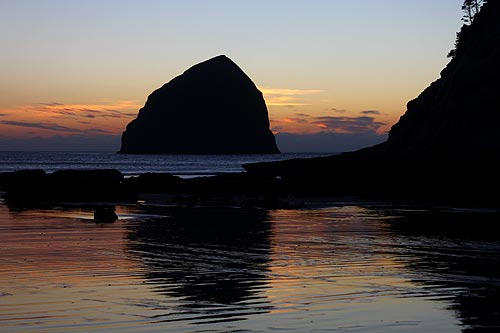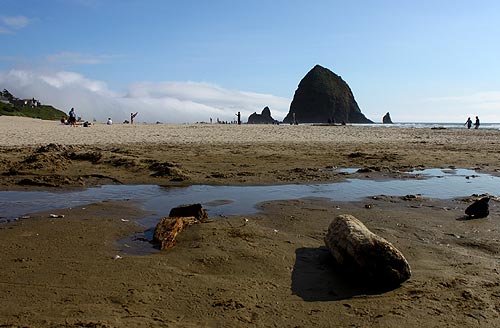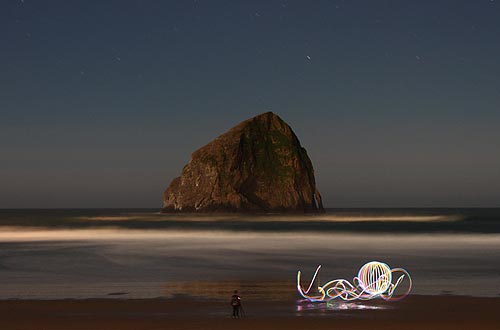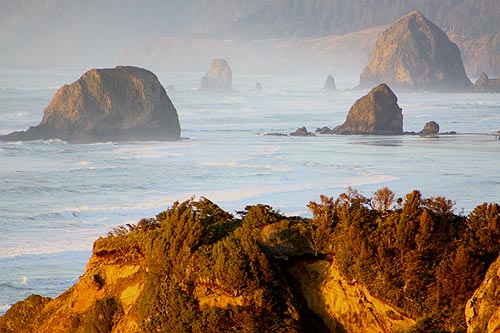Tale of Two (or More) Haystack Rocks on Oregon Coast
Published 12/02/2012

(Cannon Beach, Oregon) – Yes, Virginia: there really are two Haystack Rocks on the Oregon coast. Visitors from out of state who tend to latch onto either Pacific City or Cannon Beach become a bit confused by this – and even a little angry by that confusion. But indeed there are two major landmarks, both regularly photographed, both by the name of Haystack Rock.
Wait just a minute: there are actually three. The last is in Bandon. More on that: Why Are There Three Haystack Rocks on the Oregon Coast
Why are there two (or more) Haystack Rocks on the Oregon coast? No one really knows the answer for sure, but before the '30s all coastal towns were quite secluded and disconnected from each other. They developed very different cultures before Highway 101 came along, and it's likely that disconnection had a hand in no one being aware that someone else had named rocks with the same name.
One is the gargantuan Haystack Rock at Pacific City, and the other is the Haystack Rock in Cannon Beach (which only looks larger because it's closer, but the Pacific City one is taller). The other is at Bandon's Face Rock area.
However, to throw another twist into this tale, there is yet a third Haystack Rock – this one in Coos County in Bandon.
Cannon Beach's Haystack Rock sits right up on the tide line of the famed north coast town, while the Haystack at Pacific City is almost a mile offshore from the landmark Cape Kiwanda. Pacific City's is a tad higher than the one at Cannon Beach, by more than 100 feet.
“The rock has an estimated height of 340.6 feet (103.8 m) as determined from Lidar data collected by our agency,” said Jonathan Allan, Coastal Geomorphologist and Coastal Section Team Leader with Oregon Department of Geology and Mineral Industries, in their Newport office.
Tom Horning, a geologist from Seaside, said the Haytack Rock in Cannon Beach is about 235 feet high.
Both Haystack Rocks are protected wildlife refuges. Although it's a moot point for the one at Pacific City, except that boaters are instructed to steer clear of the rock structure. At Cannon Beach, you're allowed to goof around the tide pool areas but not climb on its base because of the bird sanctuary there.
Both have been Oregon landmarks for – literally – millions of years. Both appear to have originated from volcano eruptions some 14 - 16 million years ago that took place in what is now Eastern Oregon. Back then, due to the way the continents have moved, there was a massive weak spot in the Earth's crust that created lava flows so enormous they slogged along for hundreds of miles, until they reached the ocean. These are known as the Columbia Basalts, since they created the Columbia Gorge as well as much of the landscape of the Oregon coast.
Haystack Rock in Cannon Beach is actually known as an “instrusive,” meaning the lava flow that it’s a part of shot its way back into the ground, probably in softer ground like mud or such, and then re-erupted again a ways away. This left blob structures that were eventually worn down into shapes we know today like the ones around Cannon Beach.
The origin of Haystack Rock in Pacific City isn't as certain, but scientists believe it's the result of a massive flow that once filled a canyon here, then eroded away into that shape in the distance. It's believed to be the same kind of basalt that comprises Cape Lookout about 15 miles to the north, though no serious testing has been done on this Haystack.

More About Oregon Coast hotels, lodging.....
More About Oregon Coast Restaurants, Dining.....
LATEST Related Oregon Coast Articles
Officials in Cannon Beach are asking for extra caution around Haystack Rock because of a pair of black oystercatchers
Cannon Beach's Haystack Holidays Return to N. Oregon Coast in Different Form
The famed north Oregon coast town of Cannon Beach has figured out a safe but fun way to continue its ages-long tradition. Cannon Beach events
'Safari' Event at Haystack Rock Takes You Deeper Into This Colorful Oregon Co...
On April 21, Haystack Awareness shows you the kooky nudibranch in details. events
Haystack Rock Awareness Program Starts Up Again on N. Oregon Coast's Cannon B...
A return to action for the 2024 season on February 16. Cannon Beach events
Cougar 'Standoff' on N. Oregon Coast: Officials Wait for Cat to Leave Haystac...
Latest: The cat has not stepped onto the sand and remained on the rock. Sciences
Names, Wordage Now Incorrect on Oregon Coast, Washington Coast: Haystack to G...
Seagulls, starfish, exploding whale and Haystack Rocks. Marine sciences. History
20 Years of Oregon Coast Preservation: Cannon Beach's Friends of Haystack Roc...
November 1 - 3 it's a part of Stormy Weather Arts Festival. Cannon Beach events
Places with Same Names on Oregon Coast: Rocky, Agate, Haystacks, China, Otter
Agate Beach's, Rocky Point, Haystack Rocks, China Creeks, Otter Points: Newport, Bandon, Brookings, Gold Beach, Depoe Bay, Cannon Beach, Pacific City
Back to Oregon Coast
Contact Advertise on BeachConnection.net
All Content, unless otherwise attributed, copyright BeachConnection.net Unauthorized use or publication is not permitted
















































